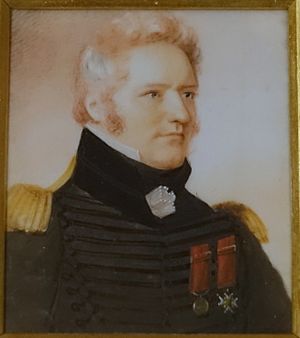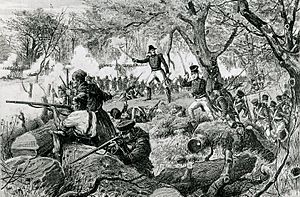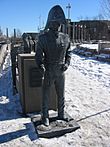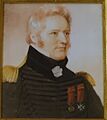Charles de Salaberry facts for kids
Quick facts for kids
Charles de Salaberry
|
|
|---|---|

Lieutenant Colonel Charles-Michel d'Irumberry de Salaberry in 1825 by Anson Dickinson
|
|
| Member of the Legislative Council of Lower Canada |
|
| In office December 14, 1818 – February 27, 1829 |
|
| Monarch | George III George IV |
| Personal details | |
| Born | November 19, 1778 Beauport, Province of Quebec |
| Died | February 27, 1829 (aged 50) Chambly, Lower Canada |
| Nationality | Canadian |
| Political party | Château Clique |
| Relatives | Ignace de Salaberry (father) Michel de Sallaberry (grand-father) |
| Military service | |
| Allegiance | British Empire Lower Canada |
| Branch/service | Canadian Militia |
| Rank | Lieutenant Colonel |
| Commands | Canadian Voltigeurs |
| Battles/wars | French Revolutionary Wars |
Charles-Michel d'Irumberry de Salaberry (born November 19, 1778 – died February 27, 1829) was a brave Canadian soldier and important leader. He was known for stopping an American attack on Montreal during the War of 1812. He also received a special award called the Order of the Bath for his service.
Contents
Early Life and Family History
Charles-Michel de Salaberry was born on November 19, 1778, in Beauport, which is near Quebec City in Lower Canada. He came from a family with a long history of military service. For many generations, his family members had been officers in the army, first in France and then in the New World.
When the British took over Canada in 1763, his family continued to serve in the British army. Charles-Michel's father, Ignace de Salaberry, was a Seigneur (a powerful landowner) and a British Army officer. His father fought to defend Quebec during the American Revolutionary War. Later, he also served in the government of Lower Canada.
Becoming a Soldier: Charles-Michel's Military Career
At just 14 years old, Charles-Michel followed his father's path and joined the British Army. He first served in the 44th Regiment and then moved to the 60th Regiment. He saw action in the West Indies.
Facing Challenges in the West Indies
While in the West Indies, his group of soldiers faced a terrible challenge. Many of them became sick with yellow fever. Their group of 200 men was greatly reduced. Despite this, they marched through the countryside to attack a fort called Fort Matilda. De Salaberry was praised for his bravery during this attack. He continued his duties even when almost all his fellow soldiers were sick or wounded. He was even put in charge of helping the few remaining soldiers escape, even though he was younger and lower in rank than some of them.
Serving in Europe and a Famous Duel
He later served well in the Netherlands during a campaign called the Walcheren Campaign. By 1799, he became a Captain-Lieutenant, and in 1803, he was given command of a company of soldiers. He continued to serve in Europe and the West Indies.
While he was stationed in Jamaica, de Salaberry was involved in a famous duel. A duel was a fight between two people, usually with swords or pistols, to settle an argument about honor. This duel was retold by Philippe-Joseph Aubert de Gaspé:
The officers in de Salaberry's regiment came from different countries. One morning, a German officer insulted French-Canadians, saying he had just killed another French-Canadian in a duel. De Salaberry was very angry but quickly calmed himself. He told the officer, "We will finish breakfast, and then you shall have the pleasure of finishing another French Canadian."
They fought with swords, and both were very skilled. De Salaberry was young, and his opponent was older and known for being a bully. De Salaberry was wounded on his forehead, which left a scar. His friends tried to stop the fight, but he refused. He tied his handkerchief around his head and fought even harder. In the end, his opponent was badly wounded and died.
Leading the Canadian Voltigeurs
In 1810, de Salaberry was called back to Canada and became a Lieutenant-Colonel. He was put in charge of a new group of volunteer soldiers called the Canadian Voltigeurs. These Voltigeurs were like a special militia (citizen soldiers), but de Salaberry trained them to be as good as regular army soldiers. He even paid for some of their equipment himself.
He did this because he respected French Canadians, who sometimes didn't want to fight alongside British soldiers. The soldiers in the Voltigeurs used French for their instructions. De Salaberry was very strict about discipline and honor, and his soldiers respected and were loyal to him.
The War of 1812: Defending Canada
In November 1812, during the War of 1812, de Salaberry led the soldiers who stopped an American attack at Lacolle Mill. Later, some of his Voltigeurs also helped in the important Battle of Crysler's Farm, which some people say "saved Canada."

The Battle of Chateauguay: A Famous Victory
De Salaberry's most famous moment came at Chateauguay in October 1813. He stopped American troops who were marching towards Montreal. He received regular updates from loyal farmers along the border, so he knew exactly where the Americans were and how many soldiers they had.
As the Americans approached the Chateauguay River, de Salaberry ordered trees to be cut down to create tangled barriers called "abatis" in the ravines. He also spread his troops through the woods. The American force had 4,000 soldiers and 10 cannons, but de Salaberry only had 250 Voltigeurs and 50 Mohawk warriors in his advance group. The rest of his soldiers, about 1,500 men, were kept in reserve.
On October 26, when the Americans reached the barriers, they sent 1,500 troops to try and surround the Canadians. De Salaberry used the dim light and the difficult forest to confuse the enemy. He ordered bugles to be blown from different places, making the Americans think a much larger army was hiding in the darkness. The Voltigeurs then fired heavily into the ravine, causing many American casualties.
Because they couldn't get around de Salaberry's forces, the American commander decided to retreat back to the American border. This victory made de Salaberry famous and earned him honors. If he had failed, he might have faced serious trouble, as he hadn't reported the American advance to his senior officers. But his plan worked! Britain even made a special gold medal to remember the Battle of Chateauguay, and de Salaberry became a hero in Quebec history.
After this victory, de Salaberry was given an important role as Inspecting Field Officer of Light Troops in Canada.
Later Years and Legacy
After the War of 1812, Charles de Salaberry became a folk hero in French Canada. He worked as a justice of the peace and, in 1818, became a member of the Legislative Council of Lower Canada, helping to make laws. When his father died, he became the Seigneur of St. Mathias.
In 1817, he was made a Companion of the Order of the Bath, a high honor. Charles de Salaberry died in Chambly, Quebec on February 27, 1829.
Remembering a Hero
There is a bronze statue of Charles de Salaberry in Chambly, Quebec. It was created by Louis-Philippe Hébert and was unveiled on October 26, 1881, to thank him for his service.
De Salaberry's house in Chambly was named a National Historic Site of Canada in 1968, recognizing its importance.
The Royal Canadian Mint has honored him on coins. On March 18, 2013, they released a quarter with his picture to celebrate 200 years since the War of 1812. They also released a two-dollar coin (Toonie) on June 18, 2012, and a four-dollar coin in honor of his victory at Chateauguay with "les Voltigeurs." In 2013, Canada Post also issued a postage stamp remembering Charles de Salaberry.
His Family Today
Charles de Salaberry has many descendants living across Canada. Two of his sons, Charles-René-Léonidas d'Irumberry de Salaberry and Melchior-Alphonse de Salaberry, also served in the army. Today, some families who carry his name live in Coquitlam, British Columbia and Ontario.
Both the City of Salaberry-de-Valleyfield in Quebec and the Rural Municipality of De Salaberry in Manitoba are named after him to remember his actions in the War of 1812. The last traditionally built armory in Canada, built in Hull in 1938, is called Le manège de Salaberry.
See also
- Colonial Militia in Canada
Images for kids
-
During the Battle of Chateauguay, de Salaberry (center) led local soldiers, militia, and Mohawk warriors against American forces.
-
Statues of de Salaberry at Quebec's Parliament Building in Quebec City
-
Statue of de Salaberry at Valiants Memorial in Ottawa









